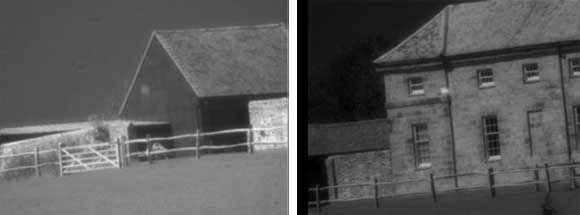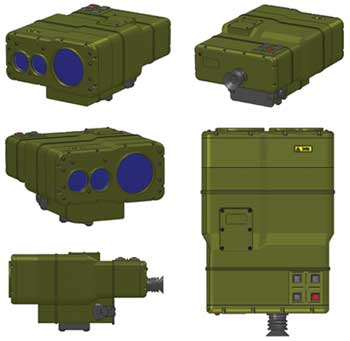John Staples, Defence Vision Systems
A new multidetector system uses multiple-wavelength sensors and lasers for rangefinding, target spotting and target illumination.
Multisensor detectors can be of great use to surveillance systems, whether they use intensified CCD, CMOS, InGaAs/short-wave infrared or long-wave infrared. These may be stand-alone systems or may incorporate a laser rangefinder, laser designator or laser illuminator.
Modern surveillance should be able to detect and identify a specific target. Detecting a target or threat and then measuring the range to it, or illuminating it, generally requires a good multiwavelength surveillance system.

These two images were taken using the InGaAs/short-wave infrared camera of the DVS STAS24 system in bright light on a May midafternoon with no clouds. The laser is clearly visible as a square on the side of the barn and the house in the distance.
However, no matter how good the system, battlefield conditions or the weather can defeat its ability to meet these requirements. Thermal systems are excellent at detection but often have difficulty with identification; therefore, many of today’s systems use various forms of laser illumination, continuous wave as well as gated, to identify or designate the target.
To date, these have tended to be used in conjunction with visible-band sensors working at 400 to 900 nm. Most of these lasers work around the 800- to 900-nm region or at 1064 nm. The most intensified night-vision devices can see the former wavelengths, but the current range of in-service sensors cannot see the latter.
Available systems generally use the laser as a means of increasing the light on and around the target, either for aiding identification or designating a building or person, or for range measurement. In range measurement, the lasers again tend to be at 1064 nm, and because no sensor can see this wavelength, the user must rely on system collimation to ensure that the laser is on the target. This means that, while effectively firing the laser blind, the user must have faith that the collimation is good.
A new solution combines a visible-band sensor and a near-infrared sensor in a series of devices incorporating lasers for rangefinding, target spotting and target illumination.
The first such system developed is the DVS STAS24 (surveillance target acquisition system) from Defence Vision Systems. It incorporates a high-resolution visible-band sensor operating from 400 to 900 nm, plus a low-resolution near-infrared sensor operating from 900 to 1700 nm, together with an eye-safe laser operating at 1550 nm. The two sensors and the laser are integrated into a single system that can provide images in lighting conditions from full sunlight down to starlight, together with a GPS and electronic compass system.
The system uses a custom lens from Davin Optronics Ltd. of Watford, UK, which designs and manufactures lenses for the defense market. The optical company developed an objective lens for the STAS24 that provides excellent images for the combined wavelengths from 400 to 1700 nm over a 24-hour period.

A computer-generated image of the 24-hour surveillance target acquisition system known as DVS STAS24, which uses a visible-band sensor plus a near-infrared sensor and lasers for rangefinding, target spotting and target illumination.
With a single 24-hour system, there is no need to swap from a day system that cannot work at night to a night system that cannot work in the day. This reduces training time and increases ease of use; it also reduces the amount of kit needed, the need for spares, the cost, and the space needed to fit the system into airborne and armored-vehicle applications. Safety is increased because users are not blind while the day system is switched to the night system.
By keeping the image optimized over the full wavelength range and providing sharp images during the 24-hour period, we do not have to change lenses when moving from day to night. Most lenses are optimized only for a small bandwidth – for example, closed-circuit television lenses are generally optimized for 400 to 600 nm, and some offer 400 to 900 nm. Combining these diverse wavelengths into a single merged and scaled image, viewed by the user through a single-channel eyepiece, enables better surveillance for various applications.
More importantly, this merged image includes the laser spot on the target, for the first time eliminating the guesswork as to its location.
The system incorporates a GPS together with an electronic compass to provide the user with location coordinates and heading. The data from the diverse imaging sensors is seen as a combined image with the range information, GPS data and compass heading visible above and below the main image.
The system features straightforward three-button operation, with the buttons being system on/off, zoom (standard magnification 11x with electronic zoom to 44x) and laser fire.
The laser’s wavelength is 1550 nm, and the user can specify at time of order from three power levels that provide maximum ranges of 2, 4 or 8 km. To ensure eye safety, the laser has a 10-second-delay default mode between operations.
At the system’s heart is a small but powerful computer, so it would be possible to record each use of the laser and the data derived. This recording would be in the form of a video showing the image of the target and the data surrounding that image. In the current climate of retrospective evaluation and analysis of events, such a system would provide a clear identification and record.
Future developments
Additional versions of the STAS24 are planned for 2013. Initially, these will involve alternative 1550-nm laser formats that will enable systems incorporating laser illuminators and laser spotters. These formats will exploit the major advantage of the system by providing the user visible illumination of the 1550-nm wavelength.
Alternative system configurations could include armored vehicle- and airborne gimbal-mounted applications.
The system is not large or power-hungry, so it offers an ideal retrofit to smaller existing armored vehicles. It could be used in conjunction with low-resolution thermal systems to help identify the target. It also would be possible to incorporate a low-resolution thermal sensor and include the input from this as part of the merged image. The system could be mounted in a bolt-on armored housing with just the wires for power, control and image penetrating the armor of the vehicle; the gimbal-mounted version would provide an ideal backup to thermal systems.
Many of the current airborne surveillance systems use lasers that are visible to anybody wearing or using intensified night vision. The advantage of the STAS system is that the laser would not be visible to any current in-use thermal or low-light sensors. And to the naked eye, the 1550-nm wavelength is not visible, so air-to-air use would not blind the pilot, saturate his night-vision goggles or cause other problems.
Meet the author
John Staples is sales director at Defence Vision Systems in East Sussex, UK; email: [email protected].
Advantages of a 24-hour system
• No need to change from a day system to a night system
• Increased safety due to continuous operation
• Smaller size for airborne/armored-vehicle applications
• Increased ease of use
• Reduced training time
• Less kit needed
• Less need for spares
• Lower cost